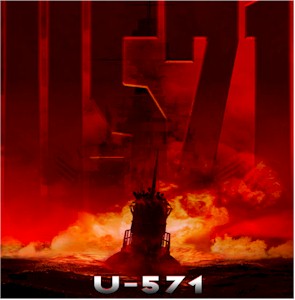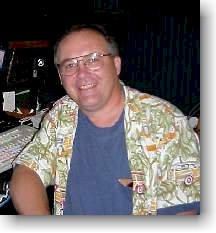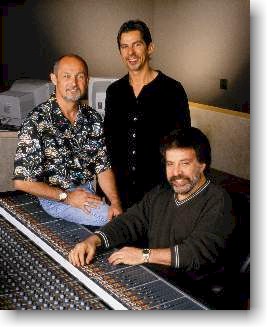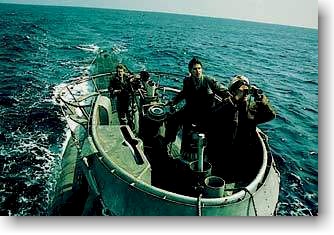
|
Eight-channel soundtrack production for
U-571
with supervising sound editor Jon Johnson
and re-recording engineers Steve Maslow,
Gregg Landaker and Rick Kline
Written in April 2000
by Mel Lambert |
U-571 is an old-fashioned, high-action submarine film. Directed/co-written by Jonathan Mostow, and starring Matthew McConaughey, Bill Paxton, Harvey Keitel and Jon Bon Jovi, "U-571" is a World War II suspense drama that details an American submarine crew's battle against time - and their own fears - while carrying out a daring mission to capture a top-secret encrypting device from a Nazi U-boat. In essence, "U-571" combines elements of "Das Boot," "The Hunt for Red October" and "Crimson Tide," but with a savage twist that keeps you guessing.
"Although my primary goal [in making 'U-571'] was to create the visceral experience of being aboard a WWII submarine," Mostow says, "I also wanted to give the audience a taste of some of the fascinating strategic aspects that occurred during the Battle of the Atlantic. The film is about submarining; the notion of facing the enemy in a container with the structural integrity of a sardine can. It's about half-inch thick steel pressure hulls that creaked and groaned and crushed like eggshells if the subs went too deep. It's about torpedoes and depth charge explosions, and the terror of battle."
 Supervising sound editor on the project was Jon Johnson of Fury & Grace (pictured left), who also worked with Mostow on "Breakdown." "It's a pleasure to work with directors who are sympathetic to the role that sound plays in the telling of a story," Johnson offers. "With Jonathan, we have developed a shorthand that lets us communicate efficiently. Jonathan likes 'moments' in his films - small textures that underscore what's happening on screen, and which can be highlighted by the soundtrack. Quite often, to support the story, he is more interested in what we choose to leave out than what we put in!" Supervising sound editor on the project was Jon Johnson of Fury & Grace (pictured left), who also worked with Mostow on "Breakdown." "It's a pleasure to work with directors who are sympathetic to the role that sound plays in the telling of a story," Johnson offers. "With Jonathan, we have developed a shorthand that lets us communicate efficiently. Jonathan likes 'moments' in his films - small textures that underscore what's happening on screen, and which can be highlighted by the soundtrack. Quite often, to support the story, he is more interested in what we choose to leave out than what we put in!"
Johnson first read the script for "U-571" in January 1999, and was immediately taken with the challenge of using his diverse sound-design skills to orchestrate the film's soundtrack. "The script contained a lot of off-stage sound effects that were intended to place the audience in the heart of this old submarine, hundreds of feet below the Atlantic. It was a great opportunity to use sound to tell a story."
In terms of sound effects, Johnson soon realized that he needed to make sure that they sounded authentic. "I researched what sort of power plant they used on submarines like these - both German and American. I also learned about the batteries, diesel engines, gear shafts, plus the pneumatic and hydraulic systems used for the periscopes. I then drew up a list of the sounds we need to record specifically for the film."
Working with a US Navy technical consultant, Admiral Patrick Hannifin, Johnson visited the USS Pampanito, a submarine built in 1942 and now moored in San Francisco. "I kept thinking to myself," he recalls, " 'How do we get that unique diesel smell into the movie?' We recorded a bunch of engine sounds, hydraulics and the 'TDC' or Torpedo Device Computer that was used to set the torpedo's arming mechanism. The sound pressure level in the engine room was very high - around 110-115 dB."
The stereo recordings made aboard USS Pampanito we captured with a variety of Audio-Technica and Sennheiser microphones, and laid to Sony and Tascam portable DAT recorders. Assisting Johnson were location recordists Miguel Rivera and Charles Maynes. "We also visited Los Angeles Harbor to record the sound of steel containers being loaded and uploaded - and being dropped! We also recorded barrels being tossed into the water, plus a number of other water-related sounds."
Johnson recalls that all location sound effects recorded from above the water surface were tracked in stereo, and underwater sounds in mono. Why mono? "Because sound travels a lot faster in water than in air, and for realistic stereo effects we would have had to keep the mics 50 feet apart. Instead, we decided to leave it up to the re-recording mixers to create any stereo or multichannel effects. We covered a [Shure] SM-58 [dynamic microphone] and a Crown PZM with an industrial balloon, and used that to capture underwater sounds. We tried using the conventional solution - a condom - but soon discovered that it was attacked by salt water."
"We recorded the sounds of boats moving through the LA Harbor," Johnson continues, "and also visited a large tank that offered a long RT60 reverb time. All in all, we recorded some 50-60 hours of location effects recordings." He also used dry ice to create the sounds of underwater bubbles. "Melted dry ice in water sounds far more realistic - 'good color' - than compressed air."
Having passed the elements to chief SFX editor Keith Bilderbeck, and sound effects editor Bruce Stubblefield, Johnson began the process of gathering the multiple elements needed for the predubs. "For the torpedo byes, for example, we had as many as 70 individual tracks playing." Investigation of the Nagra D daily rolls by dialog editor Robert Troy, and well-recorded loops by ADR editor Val Kuklosky, "provided a seamless transition between the two on the dialog track," Johnson offers.
Need for more playback loudspeaker channels
During the various Temp Dubs, as the director and supervising sound editor auditioned different mixes against a work-in-progress picture edit, Johnson realized that something was missing. "We were Temping in six-track [conventional 5.1-channel] but the mixes lacks that 'oomph' which Jonathan was after. They sounded fine, but he wanted to wake up the audience during the depth charge scenes, for example. And build such a feeling of anticipation that when the next attack began, the audience would be cringing in anticipation.
So the director decided to use the additional channels available from Sony's SDDS 8 Channel format to provide an enhanced sense of realism. "Having that extra pair of Inner-left and Inner-right channels gives you a lot more 'sonic horsepower' behind the screen," Johnson confides. "Also, we had an extra pair of locations into which I could assign high-impact sounds, including explosions, machine guns, aircraft and cannons. In general, for backgrounds we used a 5.1-channel overall balance, and saved the SDDS 8 Channel for major sonic fireworks - when we needed to go to '11.' "
 Johnson says that the re-recording mixers, Steve Maslow (dialog), Gregg Landaker (effects) and Kevin Kline (music), made full use of the extra creative opportunities offered by an SDDS 8 Channel soundtrack. The Maslow and Landaker team has been together since 1978, and received AMPAS Oscars® for Best Achievement in Sound for their work on "Speed," "Raiders of The Lost Ark," and "The Empire Strikes Back." Kline has been nominated for nine Academy Awards, most recently for Best Achievement in Sound on last year's "The Mummy." [Pictured right: Landaker, Kline and Maslow.] Johnson says that the re-recording mixers, Steve Maslow (dialog), Gregg Landaker (effects) and Kevin Kline (music), made full use of the extra creative opportunities offered by an SDDS 8 Channel soundtrack. The Maslow and Landaker team has been together since 1978, and received AMPAS Oscars® for Best Achievement in Sound for their work on "Speed," "Raiders of The Lost Ark," and "The Empire Strikes Back." Kline has been nominated for nine Academy Awards, most recently for Best Achievement in Sound on last year's "The Mummy." [Pictured right: Landaker, Kline and Maslow.]
"In the analog days - before these new digital formats came along - a 70 mm print with six discrete audio tracks was the only way we could deliver maximum impact to the audience," says Landaker, "with more loudspeaker channels up front. Using SDDS 8 Channel, with five horns across the front and split surrounds, filmmakers can deliver a high-impact soundtrack that sounds just like it does here on the re-recording stage.
"Six-channel is okay, but eight channels deliver that much more power and clarity. With conventional soundtracks, it is often hard to make it sound convincing when you are trying to accommodate soft dialog sections, with a high degree of intimacy, and then move to a major action sequence. For movies like "U-571,' we really needed the wide and comfortable dynamic range offered by 'five-across-the-front' loudspeakers speakers and split surrounds offered by SDDS 8 Channel."
"Normally we only have the center channel for important dialog and special effects," Maslow offers. If you spread the effects too wide, you end up with the 'Exit Sign' phenomenon - the audience keeps turning their heads from left to right, as the sound comes from these hard-left and hard-right locations. We can now use the center channel for dialog, and the extra [inner-left and -right SDDS] channels for sound effects and music tracks, without muddying up the center."
Landaker concurs. "By keeping my effect tracks out of the center dialog channel, I can let Steve concentrate on the essentials of the plot and character development, while the effects draw the audience into the heart of the movie."
Confirming Jon Johnson's recollections, Maslow says that in December 1999 the team prepared a six-channel Temp Dub for director Jonathan Mostow. "It became obvious," Steve Maslow remembers, "that Jonathan wanted a 'bigger sound' - the submarine interiors, explosions and the battle scenes needed more dynamic range. We knew that we were running out of headroom."
"So we made an SDDS 8 Channel Temp of the loud scenes," Landaker continues, "just to let Jonathan hear what the format could deliver. We chose a scene with loud explosions and depth charge sounds. Compared to the six-channel Temp Dub, Jonathan was impressed that we could hold back on the [soundtrack], and still deliver the type of impact he was after in key scenes. 'U-571' is a real roller-coaster ride for the audience; the soundtrack ranges from quiet interior scenes to depth charge attacks which we wanted to heighten so that the audience would really understand what it was like during a loud sea battle.
"Then, having established that sense of reality, we wanted to make sure that the next time an attack happened on screen, the audience knew a terrifying event was about to occur. We needed that dynamic range from dead quiet to very loud sound effects. We soon realized that SDDS 8 Channel was the way of delivering that wide a dynamic range for the director."
"We pre-dubbed effects tracks for the SDDS 8 Channel soundtrack with Tascam MMR-8 Digital Dubbers," Gregg Landaker continues, with full backwards compatibility with Digidesign Pro Tools workstations for editorial changes. "And we used high-precision Apogee 24- bit analog-to-digital converters to preserve every nuance of sound. We had something like 100-plus tracks for backgrounds, plus 250 stereo elements of sound effects, with close to 75 tracks of torpedo sounds, for example, to cover the gamut from quiet details to complex explosions."
 "My biggest challenge," offers Maslow, "was to keep the dialog intact, and the way in which it was presented to me. By which I mean that if the crew were talking quietly, I needed to be able to leave it alone, but if they were yelling at one another in the battle scenes then we could bring in the music and effects for emphasis. But to achieve that I needed a wide dynamic range, and one that would let us handle the range from a whisper to a sonic extravaganza. SDDS worked very well." "My biggest challenge," offers Maslow, "was to keep the dialog intact, and the way in which it was presented to me. By which I mean that if the crew were talking quietly, I needed to be able to leave it alone, but if they were yelling at one another in the battle scenes then we could bring in the music and effects for emphasis. But to achieve that I needed a wide dynamic range, and one that would let us handle the range from a whisper to a sonic extravaganza. SDDS worked very well."
With close to 70 minutes of music in "U-571," Rick Kline was kept busy with balancing Richard Marvin's score, which was recorded by Dennis Sands at Sony Scoring Stage, Culver City. "Dennis recorded a 5-1-channel mix," Kline recalls, "with a number of individual elements, including piano, synthesizer, drums and percussion, broken out on additional tracks. We received [from music editor Daryl Kell] a Tascam MMP-16 plus up to dozen individual Pro Tools tracks.
"For me, the SDDS 8 Channel format provided seamless pans and moves during, for example, a dance orchestra scene when the camera follows Matthew McConaughey as he moves through the room. With five horns up front, I could locate the sound more accurately and realistically. I also used the extra inner channels for low-frequency instruments, including a Grand Cassa, or bass drum. We also found that by mastering in SDDS 8 Channel, when the time came to prepare the stereo optical Lt-Rt, we could ensure that sound stayed where we panned them, rather than being lost by the matrix, which can often be the case if you start with a basic 5.1-channel mix."
According to George Borghi, Director of Sound & Video Operations at Universal Post Production Group, "We made a conscious decision to equip all of our feature dub stages, and many of our screening rooms, with discreet eight-channel monitoring. With five speakers up front, Tascam dubbers, dedicated workstation bays, and all our Academy acknowledged mix teams, we can give directors soundtracks with as much impact and nuance as they can imagine."
Photographs
courtesy of Universal Studios.


©2023 Media&Marketing. All Rights Reserved. Last revised: January 20, 2009.
|



